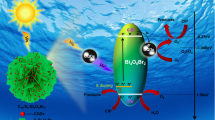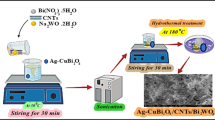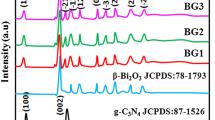Abstract
Carbon nanotube (CNT)-bridged Z-scheme Bi2WO6/C3N4 ternary heterojunctions (BCT) were prepared through a two-step hydrothermal method. Field emission scanning electron microscope and transmission electron microscope images reveal the flower-like structures of prepared samples. The modification of C3N4 and CNT leads to an improved specific surface area without affecting the morphology of Bi2WO6. Optical characterizations demonstrate an improved visible light absorption for the BCT sample compared to the pure Bi2WO6 and other binary Bi2WO6/C3N4, Bi2WO6/CNT composites. Moreover, the formation of intimate ternary heterointerface (identified by HRTEM images) effectively facilitates the interfacial carrier separation and reduces the recombination of electron–hole pairs, as indicated by a series of electrochemical characterizations. The prepared BCT3 photocatalyst (incorporated with 5% of C3N4 and 1.67% of CNT) posses 0.0304 min−1 of ciprofloxacin photodegradation rate, which is a superior value than related Bi2WO6 and C3N4-based composite photocatalysts. The work functions, electronic structure and charge density difference were calculated by employing density functional theory method. The results suggest that the photogenerated electrons would transfer from Bi2WO6 to C3N4, bridging by the CNT with great conductivity and suitable work function. This charge transfer pathway corresponds to the formation of Z-scheme mechanism in prepared BCT composites, which is also supported by the trapping experiments and electron spin resonance analysis. We anticipate that the present work will be helpful for constructing highly efficient ternary Z-scheme photocatalysts by coupling a small amount of CNT as a non-noble metal cocatalyst.
Graphic abstract
3D Flower-like Bi2WO6/C3N4/CNT Z-scheme ternary composite was successfully synthesized and utilized as high-performance photocatalyst for degrading a wide range of organic pollutants.













Similar content being viewed by others
References
Ding J, Dai Z, Qin F, Zhao H, Zhao S, Chen R (2017) Z-scheme BiO1−xBr/Bi2O2CO3 photocatalyst with rich oxygen vacancy as electron mediator for highly efficient degradation of antibiotics. Appl Catal B 205:281–291. https://doi.org/10.1016/j.apcatb.2016.12.018
Zou J, Wu K, Wu H, Guo J, Zhang L (2020) Synthesis of heterostructure δ-MnO2/h-MoO3 nanocomposite and the enhanced photodegradation activity of methyl orange in aqueous solutions. J Mater Sci 55:3329–3346. https://doi.org/10.1007/s10853-019-04225-w
Song S, Wu K, Wu H, Guo J, Zhang L (2020) Synthesis of Z-scheme multi-shelled ZnO/AgVO3 spheres as photocatalysts for the degradation of ciprofloxacin and reduction of chromium(VI). J Mater Sci 55:4987–5007. https://doi.org/10.1007/s10853-019-04316-8
Wen X-J, Niu C-G, Zhang L, Liang C, Guo H, Zeng G-M (2018) Photocatalytic degradation of ciprofloxacin by a novel Z-scheme CeO2–Ag/AgBr photocatalyst: influencing factors, possible degradation pathways, and mechanism insight. J Catal 358:141–154. https://doi.org/10.1016/j.jcat.2017.11.029
Song S, Wu K, Wu H, Guo J, Zhang L (2019) Effect of Fe/Sn doping on the photocatalytic performance of multi-shelled ZnO microspheres: experimental and theoretical investigations. Dalton Trans 48:13260–13272
Ke J, Duan X, Luo S et al (2017) UV-assisted construction of 3D hierarchical rGO/Bi2MoO6 composites for enhanced photocatalytic water oxidation. Chem Eng J 313:1447–1453. https://doi.org/10.1016/j.cej.2016.11.048
Song S, Wu K, Wu H, Guo J, Zhang L (2019) Multi-shelled ZnO decorated with nitrogen and phosphorus co-doped carbon quantum dots: synthesis and enhanced photodegradation activity of methylene blue in aqueous solutions. RSC Adv 9:7362–7374
Wang R, Cheng G, Dai Z, Ding J, Liu Y, Chen R (2017) Ionic liquid-employed synthesis of Bi2E3 (E = S, Se, and Te) hierarchitectures: the case of Bi2S3 with superior visible-light-driven Cr(VI) photoreduction capacity. Chem Eng J 327:371–386. https://doi.org/10.1016/j.cej.2017.06.119
Zou X, Yuan C, Dong Y, Ge H, Ke J, Cui Y (2020) Lanthanum orthovanadate/bismuth oxybromide heterojunction for enhanced photocatalytic air purification and mechanism exploration. Chem Eng J. https://doi.org/10.1016/j.cej.2019.122380
Luo S, Ke J, Yuan M et al (2018) CuInS2 quantum dots embedded in Bi2WO6 nanoflowers for enhanced visible light photocatalytic removal of contaminants. Appl Catal B 221:215–222. https://doi.org/10.1016/j.apcatb.2017.09.028
Yi H, Qin L, Huang D et al (2019) Nano-structured bismuth tungstate with controlled morphology: fabrication, modification, environmental application and mechanism insight. Chem Eng J 358:480–496. https://doi.org/10.1016/j.cej.2018.10.036
Ma T, Wu J, Mi Y, Chen Q, Ma D, Chai C (2017) Novel Z-Scheme g-C3N4/C@Bi2MoO6 composite with enhanced visible-light photocatalytic activity for β-naphthol degradation. Sep Purif Technol 183:54–65. https://doi.org/10.1016/j.seppur.2017.04.005
Wang K, Li Y, Li J, Zhang G (2020) Boosting interfacial charge separation of Ba5Nb4O15/g-C3N4 photocatalysts by 2D/2D nanojunction towards efficient visible-light driven H2 generation. Appl Catal B. https://doi.org/10.1016/j.apcatb.2019.05.032
Mao N, Gao X, Zhang C et al (2019) Enhanced photocatalytic activity of g-C3N4/MnO composites for hydrogen evolution under visible light. Dalton Trans 48:14864–14872. https://doi.org/10.1039/c9dt02748c
Guo W, Fan K, Zhang J, Xu C (2018) 2D/2D Z-scheme Bi2WO6/Porous-g-C3N4 with synergy of adsorption and visible-light-driven photodegradation. Appl Surf Sci 447:125–134. https://doi.org/10.1016/j.apsusc.2018.03.080
Zhao Y, Liang X, Wang Y et al (2018) Degradation and removal of Ceftriaxone sodium in aquatic environment with Bi2WO6/g-C3N4 photocatalyst. J Colloid Interface Sci 523:7–17. https://doi.org/10.1016/j.jcis.2018.03.078
Wang Y, Bai X, Pan C, He J, Zhu Y (2012) Enhancement of photocatalytic activity of Bi2WO6 hybridized with graphite-like C3N4. J Mater Chem. https://doi.org/10.1039/c2jm16873a
Li M, Zhang L, Fan X, Zhou Y, Wu M, Shi J (2015) Highly selective CO2 photoreduction to CO over g-C3N4/Bi2WO6 composites under visible light. J Mater Chem A 3:5189–5196. https://doi.org/10.1039/c4ta06295g
Samsudin MFR, Bacho N, Sufian S, Ng YH (2019) Photocatalytic degradation of phenol wastewater over Z-scheme g-C3N4/CNT/BiVO4 heterostructure photocatalyst under solar light irradiation. J Mol Liq 277:977–988. https://doi.org/10.1016/j.molliq.2018.10.160
Jiang D, Ma W, Xiao P, Shao L, Li D, Chen M (2018) Enhanced photocatalytic activity of graphitic carbon nitride/carbon nanotube/Bi2WO6 ternary Z-scheme heterojunction with carbon nanotube as efficient electron mediator. J Colloid Interface Sci 512:693–700. https://doi.org/10.1016/j.jcis.2017.10.074
Ma D, Wu J, Gao M, Xin Y, Ma T, Sun Y (2016) Fabrication of Z-scheme g-C3N4/RGO/Bi2WO6 photocatalyst with enhanced visible-light photocatalytic activity. Chem Eng J 290:136–146. https://doi.org/10.1016/j.cej.2016.01.031
Wang J, Tang L, Zeng G et al (2016) Plasmonic Bi metal deposition and g-C3N4 coating on Bi2WO6 microspheres for efficient visible-light photocatalysis. ACS Sustain Chem Eng 5:1062–1072. https://doi.org/10.1021/acssuschemeng.6b02351
Xiao X, Wei J, Yang Y, Xiong R, Pan C, Shi J (2016) Photoreactivity and mechanism of g-C3N4 and Ag Co-modified Bi2WO6 microsphere under visible light irradiation. ACS Sustain Chem Eng 4:3017–3023. https://doi.org/10.1021/acssuschemeng.5b01701
Wang Y, Jiang W, Luo W, Chen X, Zhu Y (2018) Ultrathin nanosheets g-C3N4@Bi2WO6 core-shell structure via low temperature reassembled strategy to promote photocatalytic activity. Appl Catal B 237:633–640. https://doi.org/10.1016/j.apcatb.2018.06.013
Ng B-J, Putri LK, Tan L-L, Pasbakhsh P, Chai S-P (2017) All-solid-state Z-scheme photocatalyst with carbon nanotubes as an electron mediator for hydrogen evolution under simulated solar light. Chem Eng J 316:41–49. https://doi.org/10.1016/j.cej.2017.01.054
Kongkanand A, Kamat PVJAN (2007) Electron storage in single wall carbon nanotubes. Fermi level equilibration in semiconductor-SWCNT suspensions. ACS Nano 1:13–21
Yang L, Luo Y, Yang L et al (2019) Enhanced photocatalytic activity of hierarchical titanium dioxide microspheres with combining carbon nanotubes as “e-bridge”. J Hazard Mater 367:550–558. https://doi.org/10.1016/j.jhazmat.2019.01.016
Tian Y, Hua G, Xu W, Li N, Fang M, Zhang L (2011) Bismuth tungstate nano/microstructures: controllable morphologies, growth mechanism and photocatalytic properties. J Alloys Compd 509:724–730. https://doi.org/10.1016/j.jallcom.2010.09.010
Xu X, Meng L, Li Y, Sun C, Yang S, He H (2019) Bi2S3 nanoribbons-hybridized 001 facets exposed Bi2WO6 ultrathin nanosheets with enhanced visible light photocatalytic activity. Appl Surf Sci 479:410–422. https://doi.org/10.1016/j.apsusc.2019.02.086
Fu J, Xu Q, Low J, Jiang C, Yu J (2019) Ultrathin 2D/2D WO3/g-C3N4 step-scheme H2-production photocatalyst. Appl Catal B 243:556–565. https://doi.org/10.1016/j.apcatb.2018.11.011
Zhou Z, Gao X, Yan J, Song D (2006) Doping effects of B and N on hydrogen adsorption in single-walled carbon nanotubes through density functional calculations. Carbon 44:939–947. https://doi.org/10.1016/j.carbon.2005.10.016
Kong XY, Lee WQ, Mohamed AR, Chai S-P (2019) Effective steering of charge flow through synergistic inducing oxygen vacancy defects and p–n heterojunctions in 2D/2D surface-engineered Bi2WO6/BiOI cascade: towards superior photocatalytic CO2 reduction activity. Chem Eng J 372:1183–1193. https://doi.org/10.1016/j.cej.2019.05.001
Shao B, Liu X, Liu Z et al (2019) A novel double Z-scheme photocatalyst Ag3PO4/Bi2S3/Bi2O3 with enhanced visible-light photocatalytic performance for antibiotic degradation. Chem Eng J 368:730–745. https://doi.org/10.1016/j.cej.2019.03.013
Ye Y, Zang Z, Zhou T et al (2018) Theoretical and experimental investigation of highly photocatalytic performance of CuInZnS nanoporous structure for removing the NO gas. J Catal 357:100–107. https://doi.org/10.1016/j.jcat.2017.11.002
Long G, Ding J, Xie L et al (2018) Fabrication of mediator-free g-C3N4/Bi2WO6 Z-scheme with enhanced photocatalytic reduction dechlorination performance of 2,4-DCP. Appl Surf Sci 455:1010–1018. https://doi.org/10.1016/j.apsusc.2018.06.072
Xu Y, Xu H, Wang L et al (2013) The CNT modified white C3N4 composite photocatalyst with enhanced visible-light response photoactivity. Dalton Trans 42:7604–7613. https://doi.org/10.1039/c3dt32871f
Li X, Xiong J, Gao X et al (2020) Novel BP/BiOBr S-scheme nano-heterojunction for enhanced visible-light photocatalytic tetracycline removal and oxygen evolution activity. J Hazard Mater 387:121690
Liu J, Yan X-T, Qin X-S et al (2019) Light-assisted preparation of heterostructured g-C3N4/ZnO nanorods arrays for enhanced photocatalytic hydrogen performance. Catal Today
Li L, Yan J, Wang T et al (2015) Sub-10 nm rutile titanium dioxide nanoparticles for efficient visible-light-driven photocatalytic hydrogen production. Nat Commun 6:1–10
Chen F, Li D, Luo B, Chen M, Shi W (2017) Two-dimensional heterojunction photocatalysts constructed by graphite-like C3N4 and Bi2WO6 nanosheets: enhanced photocatalytic activities for water purification. J. Alloys Compd 694:193–200. https://doi.org/10.1016/j.jallcom.2016.09.326
Zhang M, Lai C, Li B et al (2019) Ultrathin oxygen-vacancy abundant WO3 decorated monolayer Bi2WO6 nanosheet: a 2D/2D heterojunction for the degradation of Ciprofloxacin under visible and NIR light irradiation. J Colloid Interface Sci 556:557–567. https://doi.org/10.1016/j.jcis.2019.08.101
Xue W, Huang D, Li J et al (2019) Assembly of AgI nanoparticles and ultrathin g-C3N4 nanosheets codecorated Bi2WO6 direct dual Z-scheme photocatalyst: an efficient, sustainable and heterogeneous catalyst with enhanced photocatalytic performance. Chem Eng J 373:1144–1157. https://doi.org/10.1016/j.cej.2019.05.069
Yue L, Wang S, Shan G, Wu W, Qiang L, Zhu L (2015) Novel MWNTs–Bi2WO6 composites with enhanced simulated solar photoactivity toward adsorbed and free tetracycline in water. Appl Catal B 176–177:11–19. https://doi.org/10.1016/j.apcatb.2015.03.043
Zhao H, Li G, Tian F, Jia Q, Liu Y, Chen R (2019) g-C3N4 surface-decorated Bi2O2CO3 for improved photocatalytic performance: theoretical calculation and photodegradation of antibiotics in actual water matrix. Chem Eng J 366:468–479. https://doi.org/10.1016/j.cej.2019.02.088
Bel Hadjltaief H, Ben Ameur S, Da Costa P, Ben Zina M, Elena Galvez M (2018) Photocatalytic decolorization of cationic and anionic dyes over ZnO nanoparticle immobilized on natural Tunisian clay. Appl Clay Sci 152:148–157. https://doi.org/10.1016/j.clay.2017.11.008
Rayaroth MP, Aravind UK, Aravindakumar CT (2018) Effect of inorganic ions on the ultrasound initiated degradation and product formation of triphenylmethane dyes. Ultrason Sonochem 48:482–491. https://doi.org/10.1016/j.ultsonch.2018.07.009
Tian C, Zhao H, Mei J, Yang S (2019) Cost-efficient graphitic carbon nitride as an effective photocatalyst for antibiotic degradation: an insight into the effects of different precursors and coexisting ions, and photocatalytic mechanism. Chem Asian J 14:162–169. https://doi.org/10.1002/asia.201801416
Ciocilteu MV, Mocanu AG, Mocanu A et al (2018) Hydroxyapatite-ciprofloxacin delivery system: synthesis, characterisation and antibacterial activity. Acta Pharm 68:129–144. https://doi.org/10.2478/acph-2018-0011
Li W, Zhang H, Lu T et al (2019) Effects of divalent metal cations and inorganic anions on the transport of tetracycline in saturated porous media: column experiments and numerical simulations. Environ Sci Process Impacts 21:1153–1163. https://doi.org/10.1039/c9em00162j
Zeng Y, Chen D, Chen T et al (2019) Study on heterogeneous photocatalytic ozonation degradation of ciprofloxacin by TiO2/carbon dots: kinetic, mechanism and pathway investigation. Chemosphere 227:198–206. https://doi.org/10.1016/j.chemosphere.2019.04.039
Yu X, Zhang J, Zhang J et al (2019) Photocatalytic degradation of ciprofloxacin using Zn-doped Cu2O particles: analysis of degradation pathways and intermediates. Chem Eng J 374:316–327
Zhang J, Yang M, Lian Y et al (2019) Ce3+ self-doped CeOx/FeOCl: an efficient Fenton catalyst for phenol degradation under mild conditions. Dalton Trans 48:3476–3485. https://doi.org/10.1039/c8dt04269a
Huang D, Li J, Zeng G et al (2019) Facile construction of hierarchical flower-like Z-scheme AgBr/Bi2WO6 photocatalysts for effective removal of tetracycline: degradation pathways and mechanism. Chem Eng J. https://doi.org/10.1016/j.cej.2019.121991
Wang K, Li Q, Liu B, Cheng B, Ho W, Yu J (2015) Sulfur-doped g-C3N4 with enhanced photocatalytic CO2-reduction performance. Appl Catal B 176–177:44–52. https://doi.org/10.1016/j.apcatb.2015.03.045
Cao S, Shen B, Tong T, Fu J, Yu J (2018) 2D/2D heterojunction of ultrathin MXene/Bi2WO6 nanosheets for improved photocatalytic CO2 reduction. Adv Funct Mater. https://doi.org/10.1002/adfm.201800136
Yu W, Chen J, Shang T, Chen L, Gu L, Peng T (2017) Direct Z-scheme g-C3N4/WO3 photocatalyst with atomically defined junction for H2 production. Appl Catal B 219:693–704. https://doi.org/10.1016/j.apcatb.2017.08.018
Xiao Q, Zhang J, Xiao C, Tan X (2008) Photocatalytic degradation of methylene blue over Co3O4/Bi2WO6 composite under visible light irradiation. Catal Commun 9:1247–1253. https://doi.org/10.1016/j.catcom.2007.11.011
Wang S, Guan Y, Wang L et al (2015) Fabrication of a novel bifunctional material of BiOI/Ag3VO4 with high adsorption-photocatalysis for efficient treatment of dye wastewater. Appl Catal B Environ 168:448–457. https://doi.org/10.1016/j.apcatb.2014.12.047
Li H, Yu H, Quan X, Chen S, Zhang Y (2016) Uncovering the key role of the Fermi level of the electron mediator in a Z-scheme photocatalyst by detecting the charge transfer process of WO3–metal–gC3N4 (Metal = Cu, Ag, Au). ACS Appl Mater Interfaces 8:2111–2119. https://doi.org/10.1021/acsami.5b10613
Wang S, Zhu B, Liu M, Zhang L, Yu J, Zhou M (2019) Direct Z-scheme ZnO/CdS hierarchical photocatalyst for enhanced photocatalytic H2-production activity. Appl Catal B 243:19–26. https://doi.org/10.1016/j.apcatb.2018.10.019
Yu W, Xu D, Peng T (2015) Enhanced photocatalytic activity of g-C3N4 for selective CO2 reduction to CH3OH via facile coupling of ZnO: a direct Z-scheme mechanism. J Mater Chem A 3:19936–19947. https://doi.org/10.1039/c5ta05503b
Acknowledgements
This project was financially supported by projects of the China Postdoctoral Science Foundation (Grant No. 2017M610491), the Key Program of the Natural Science Foundation of the Hubei Province (Grant No. 2016CFA079), the Scientific Research Plan Project of the Education Department of the Hubei Province (Grant No. B2019377).
Author information
Authors and Affiliations
Corresponding author
Ethics declarations
Conflict of interest
The authors declare that there is no conflict of interest regarding the publication of this paper.
Additional information
Handling Editor: Joshua Tong.
Publisher's Note
Springer Nature remains neutral with regard to jurisdictional claims in published maps and institutional affiliations.
Electronic supplementary material
Below is the link to the electronic supplementary material.
Rights and permissions
About this article
Cite this article
Wu, K., Song, S., Wu, H. et al. Facile synthesis of flower-like Bi2WO6/C3N4/CNT ternary composite with enhanced photoactivity: influencing factors and mechanism. J Mater Sci 55, 15945–15962 (2020). https://doi.org/10.1007/s10853-020-05139-8
Received:
Accepted:
Published:
Issue Date:
DOI: https://doi.org/10.1007/s10853-020-05139-8




